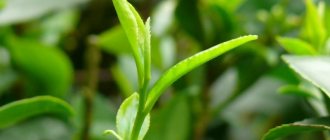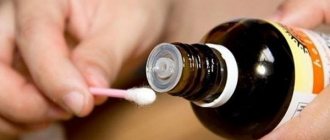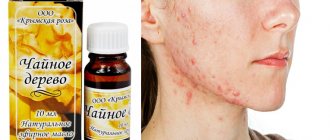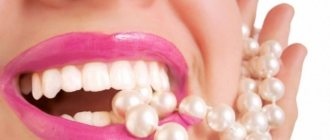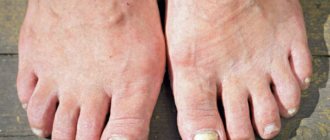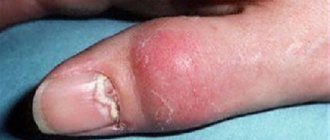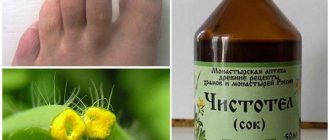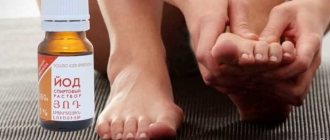Table of contents
- What is a fungal nail infection?
- Contraindications
- Preventing Fungal Nail Infection
If you notice that your toenails have turned yellow or dark brown and their texture is loose or wavy, it is very possible that it is a fungal infection. It can affect one or more toes. Usually the thumb becomes infected first, then the fungus spreads to other fingers.
There are a number of medications available, many of which are available without a prescription, but they are generally quite expensive. In addition, for this purpose it is recommended to combine the use of antifungal drugs externally and internally. When taken orally, antifungal medications have a very negative effect on liver health.
Tea tree oil is a budget-friendly product that is easy and safe to use. But the most important thing is that this natural medicine really helps, although not many doctors will appreciate it.
How can tea tree oil help?
Tea tree oil is a common remedy that will quickly return your nails to their beautiful appearance.
The effectiveness of using tea tree oil against fungus is due to the antiseptic properties of this product. The oil prevents the spread of pathogenic microflora to healthy skin and nails, allowing fungal infection to be limited to only one area. At the same time, the product creates an acidic environment on the surface of the nail, in which pathogenic microflora cannot multiply. This leads to the gradual death of the fungal colony.
Features of tea tree oil:
- prevents the spread of infection,
- improves the appearance of skin and nails,
- stimulates regeneration,
- increases local immunity.
The product can be used for fungal infections of the nails and skin of the feet. The oil is used externally only. To avoid burns, it is recommended to mix it with water or other anti-fungal agents.
To treat nail fungus with tea tree oil, lotions, compresses and baths are used. All methods are equally effective and can be used both as an independent remedy and in addition to drug therapy.
Precautionary measures
Despite all the usefulness of the essential product, it can cause allergic reactions. Therefore, before using tea tree nail oil for medicinal and cosmetic purposes, you need to test the body’s sensitivity to its components.
To do this, at the very beginning of the procedure, take a drop of ether and distribute it on the inside of the wrist or elbow. Wait 40-45 minutes and, if no unpleasant sensations such as burning, rash, or redness occur, the drug can be safely used to care for nails and cuticles.
Rules for conducting procedures
It is necessary to pay attention to the choice of tea tree essential oil for nail fungus. In order for the therapy to be truly effective, it is necessary to purchase a high-quality natural remedy, but not synthetic oils. This oil is quite expensive, but is highly effective against fungal skin infections and does not cause side effects.
The best oils are those made in India or China. You can purchase them in specialized stores and pharmacy chains.
How best to treat nail fungus with tea tree oil depends on the symptoms. In case of mild damage to the nail plates, the oil can be used as an independent remedy in the form of compresses or baths. In advanced onychomycosis, it is used only as an adjuvant to complement drug therapy.
Read also: What is trichophytosis?
Before you start using the oil or preparing medicines based on it, you need to properly prepare for the procedure.
- Using tea tree oil for nail fungus begins with preparation. To begin with, your nails should be steamed. To do this, you need to prepare a foot bath, filling it with a fairly hot solution with antiseptic properties. You can also add oil to the bath.
- After the nails are steamed, they must be treated with a nail file and all irregularities must be thoroughly cleaned. To avoid self-infection, it is recommended to use disposable manicure instruments.
- After treating your nails, your feet should be rinsed again with water and dried thoroughly with a towel. Then you can begin treatment procedures.
This algorithm of actions must be repeated daily before going to bed. It is also recommended to apply any anti-fungal remedies before bedtime and not rinse off.
Benefits of oil for fungal diseases
Tea tree oil is obtained from the branches and leaves of the melaleuca tree, which is native to Australia. The product is obtained by steam distillation, which preserves all valuable substances.
During World War II, tea tree oil was considered a strategic military medicine stockpile.
Tea tree oil contains about 50 biologically active substances. Its powerful antiseptic effect has long attracted the attention of Australian aborigines, and in the twenties of the last century the industrial use of the product began.
The chemical composition of tea tree essential oil provides the medicinal properties of the product
The oil has the following properties:
- antimicrobial;
- anti-inflammatory;
- antiviral;
- antifungal.
When treating a fungal infection with tea tree oil, the external manifestations of the disease (itching, peeling, destruction of the nail plate, unpleasant odor, etc.) disappear, and the growth and reproduction of microorganisms that provoke the development of the disease are blocked.
Video: beneficial properties of tea tree oil
Pure oil treatment
Using pure oil is one of the traditional methods for eliminating nail fungus
The easiest way to use tea tree for fungus is to use pure oil. This product is very active and in its pure form can cause burns, so care must be taken. The oil can only be applied to the nails, but not to the periungual ridges or the skin of the feet. To do this, you need to take a cotton swab, moisten it generously with oil and carefully treat the nail plate with it. There is no need to rinse off the product.
Tea tree oil against nail fungus can be applied differently. In case of severe damage to the nail plates or fear of getting burned, the product can be mixed with any vegetable oil. For onychomycosis, it is recommended to use sea buckthorn oil - it is a potent antiseptic and increases the regenerative abilities of the epidermis. To do this, take 10 drops of sea buckthorn oil and 5 drops of tea tree oil, soak a cotton swab or brush in the product and apply to the nail.
Treatment with undiluted oil is carried out daily before bedtime. If you use a mixture with sea buckthorn oil, you should treat your nails twice a day, morning and evening.
Read also: Rules for using whiteness against nail fungus
Clinical symptoms of mycoses of the hands, feet and nails
Clinical manifestations of mycosis depend on its type. The most common signs of fungal-affected skin:
- dry skin;
- change in its color (redness, cyanosis);
- thickening of the skin due to thickening of its surface layers;
- characteristic peeling, different from the peeling of healthy epidermis - cells exfoliate in clusters in the form of plates, lumps or bran;
- specific odor (in particular, especially pronounced if the feet are affected).
He is able to develop very quickly. Therefore, you should immediately consult a doctor if there are signs of the initial stage of nail fungus.
Signs of mycosis of nails:
- thickening and looseness of the nail plates;
- their dullness;
- the color of the nail plates is dirty gray, yellow or yellow-brown;
- If the disease is not treated, in advanced cases the nail plate peels off.
Fungus baths
Foot baths are the first remedy for onychomycosis. They can be prepared according to different recipes.
- Pour 15 drops of tea tree oil into a bowl of water. Place your feet in the mixture for 20 minutes, then wipe dry and apply oil to each nail.
- Dissolve 3 tablespoons of baking soda, 1 tablespoon of iodine and 10 drops of tea tree oil in water. Keep your feet in the solution for 15 minutes.
- Brew calamus root by pouring two tablespoons of crushed root with a glass of boiling water. Pour the resulting infusion into a bowl of water, adding 10 drops of tea tree oil. Keep your feet in the water for 20 minutes.
Baths perfectly prepare nails for the application of potent products and help prevent the spread of pathogenic microflora to the skin of the feet. They must be done daily before bed for three weeks.
Compresses and ointments with oil for fungus
Ointments should be applied only to pre-steamed and treated nails
Essential oils are a universal remedy that can be used both in pure form and in combination with other products. Based on tea tree oil, you can prepare mixtures for compresses and lotions against fungus.
- Mix 3 drops of tea tree oil and lavender, add a tablespoon of sea buckthorn oil. Soak a cotton pad in the product and apply to the affected nail for half an hour.
- Mix a tablespoon of butter with 5 drops of tea tree oil. Apply the ointment under the compress, leave for an hour, and then rinse with water.
- Mix honey, soda, sea salt in equal proportions, add a little water and 3 drops of tea tree oil. Apply the resulting product to the nail, securing with a bandage and cling film. Leave for two hours and then wash off the residue with water.
- Mix a small spoonful of thyme and olive oil, add 3 drops of tea tree oil. Apply the resulting product to each nail under a bandage and leave overnight.
Read also: Nail fungus on the thumb: causes of fungal infection, diagnosis and treatment
Overpowered products should be applied only to previously steamed and treated nails to ensure penetration of the active components deep into the nail plate.
Contraindications and side effects
Having figured out how to get rid of fungal diseases and how to treat fungus with tea tree oil, you should be careful, as the product is unsafe. Contraindications to the use of oil:
- pregnancy and lactation,
- individual intolerance,
- the presence of open wounds in the area treated with oil,
- childhood.
Improper use of the product can lead to destruction and detachment of the nail plates. Since children's nails are much thinner than adults', the product is not recommended for use in treating fungus in children under 6 years of age.
History, composition and beneficial properties
What we call the tea tree is actually an Australian evergreen plant Melaleuca alternifolia from the myrtle family, a relative of eucalyptus.
The name is associated with James Cook, who prepared a pleasant tea-like drink from the leaves of this plant during an expedition to Australia. The Australian aborigines have always been confident in the benefits of the tree and actively used its properties. This experience was adopted by Europeans during the settlement of the Australian continent. At the beginning of the 20th century, scientists became interested in the plant, and scientific research only confirmed its unique properties.
The 50s of the 20th century brought fashion for synthetic drugs, and tea tree oil was partially forgotten. Today, when it has already been proven that synthetic medications, in addition to their benefits, often entail side effects and complications, interest in natural medicines is being revived.
The essential oil is extracted from the leaves and branches of Melaleuca alternifolia.
What does tea tree ether consist of?
Tea tree oil is unique in its composition; it is a strong leader among other esters in terms of beneficial properties and harmlessness to the human body . It contains about 50 components that provide undeniable benefits to the human body. Some organic components are found almost nowhere else.
Useful properties and applications
The properties of the oil are numerous:
- antiseptic (this is one of the most powerful natural antiseptics);
- pronounced antibacterial and antiviral properties;
- antifungal effect.
Today the drug is actively used to treat:
- inflammatory processes and colds;
- skin diseases;
- various infections;
- fungal diseases.
The calming effect of the oil, as well as the ability to strengthen the immune system, have been noticed and appreciated. The product is used externally for lubrication, rubbing, rinsing, inhalation, and also internally in certain proportions and dosages.
Tea tree oil is actively used in aromatherapy, and is also included in many beauty and health products - creams, shampoos, gels, etc.
Release form, what to look for when purchasing
The drug is sold in pharmacies, in the form of a concentrated solution, packaged in small bottles, it is very inexpensive, and no prescription is required.
The quality of a product is determined by the content of diterpenes in it; if this figure is more than 30%, then the quality is beyond doubt. If the cineole content is more than 15%, caution must be exercised; such a concentration of cineole can cause skin irritation.

